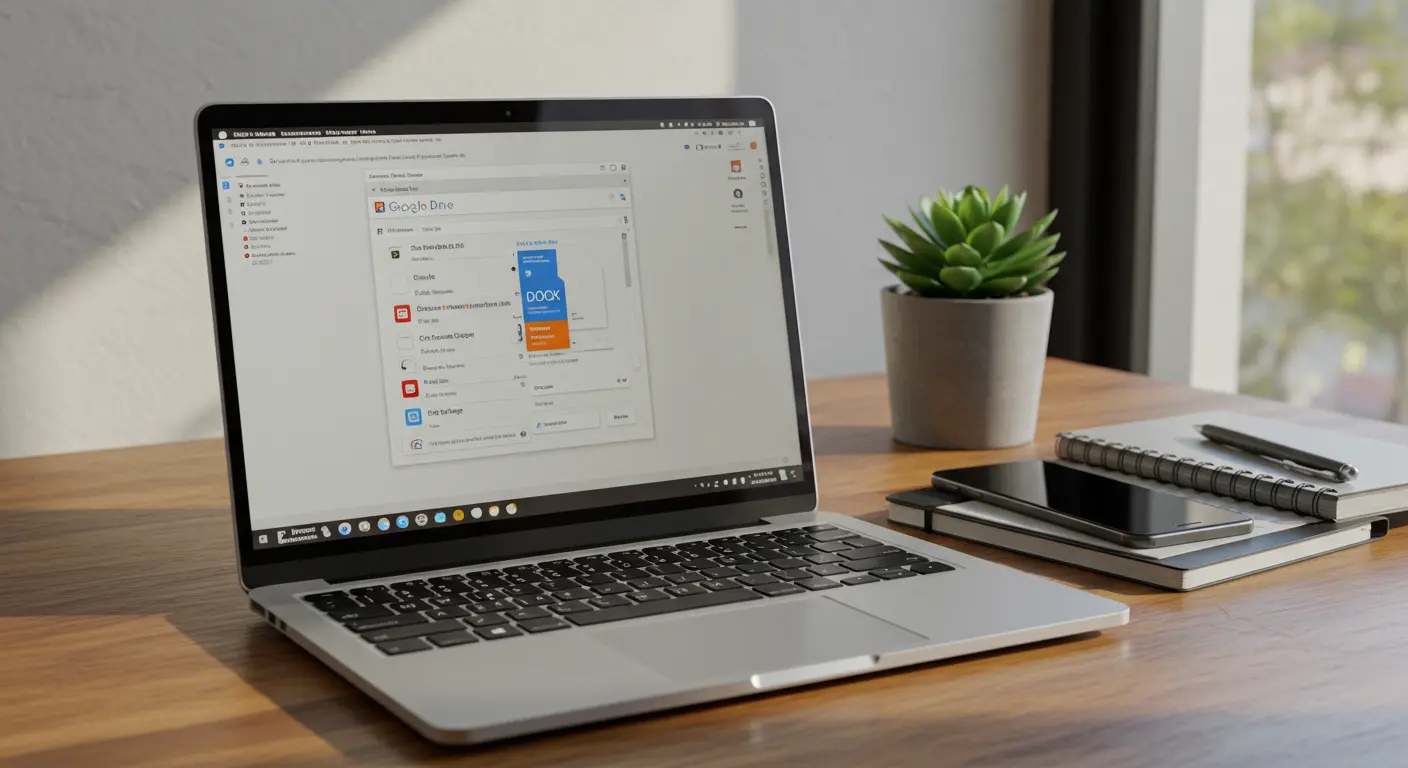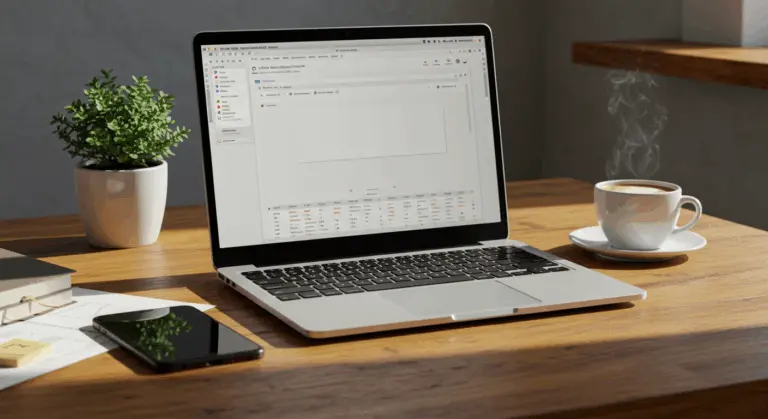How to Open a DOCX File in Google Docs – Step-by-Step Guide
Accessing Google Drive on Different Devices
What makes Google Drive stand out is its excellent cross-platform accessibility—connecting all your devices when working with DOCX files.
On Desktop Computers:
-
Open a web browser and navigate to drive.google.com.
-
Sign in with your Google account.
-
Install the Google Drive for Desktop application for offline file access.
-
Use keyboard shortcuts (e.g., Shift’T) to create new documents quickly.
-
Enable dark mode for reduced eye strain.
On Mobile Devices:
-
Download the Google Drive app (iOS or Android) and sign in.
-
Tap the ‘+’ button to upload files.
-
Use the ‘Available offline’ feature to access DOCX files without an internet connection.
-
Set up automatic camera uploads to back up photos.
-
Use the document scanning feature to digitize physical papers.
On Chrome books:
-
Use the built-in Files app, where Drive is deeply integrated for fast file handling.
-
Access Drive through the web browser (drive.google.com).
-
Use the Quick Access section to find recent files.
-
Enable offline access in the Google Drive settings.
Google Drive’s synchronization works seamlessly: changes made on one device instantly appear across all others. This cross-platform functionality changes how you work with documents—no more Microsoft Word dependency, no more device limitations. Perfect for collaboration or those constantly on the move.
Google Drive also offers device-specific features that can improve your DOCX workflow:
On Desktop Computers:
-
Install Google Drive for Desktop application for offline access to your files
-
Use keyboard shortcuts like Shift’T to create new documents quickly
-
Enable dark mode for reduced eye strain during night sessions
On Mobile Devices:
-
Set up automatic camera uploads to back up photos directly to Drive
-
Use the ‘Available offline’ feature to access important DOCX files without internet
-
Utilize the document scanning feature to convert physical documents into digital files
On Chrome books:
-
Take advantage of the deeper integration with Chrome OS for faster file handling
-
Use the Quick Access section to find recently opened DOCX files
-
Enable offline access through the Google Drive settings
Google Drive excels at its synchronization capabilities ensure that any changes you make to DOCX files on one device will automatically appear across all your devices. This integration is valuable for collaborative projects or when you’re constantly switching between devices throughout your workday. Gone are the days of emailing files to yourself or fumbling with USB drives—Google Drive eliminates these hassles entirely.
Opening DOCX Files in Google Docs
Once your DOCX files are safely stored in Google Drive, opening them in Google Docs is straightforward. Here are several methods:
Method 1: Direct Opening
The simplest approach is to double-click the DOCX file. Depending on your settings, this will either open it directly in Google Docs or display a preview window where you can click the ‘Open with Google Docs’ button at the top.
Method 2: Right-Click Menu
When you need more precise control over the opening process:
-
Locate your DOCX file in Google Drive
-
Right-click on the file
-
Select ‘Open with’ from the dropdown menu
-
Choose ‘Google Docs’ from the available options
Method 3: Converting to Google Docs Format
For the best editing experience, converting the file to Google Docs format works well:
-
Open the DOCX file in Google Docs using either method above
-
Click on ‘File’ in the top menu
-
Select ‘Save as Google Docs’
-
A new copy of the document will be created in Google Docs format
Keep in mind that your experience may vary by device. On PCs, DOCX files typically open with full functionality intact. However, on Chrome books, they might open in a limited-feature extension, making conversion essential for comprehensive editing.
Whether you’re using the Files app on a Chromebook or accessing files through a mobile device, the process remains consistent: locate your file within the Google Drive app or website, then apply one of the methods outlined above.
Using the Office Editing Extension
Google Chrome’s ‘Office Editing’ extension can sometimes complicate your DOCX workflow. Understanding its behavior—and knowing when to disable it—helps ensure smooth document management.
What is the Office Editing Extension?
This extension allows you to view and edit Microsoft Office files directly in your browser without conversion. While convenient, it can create friction when you need Google Docs’ full editing environment.
When to Disable the Extension
If you’re having these issues, the Office Editing extension might be the cause:
-
DOCX files opening in a limited-functionality viewer instead of Google Docs
-
Missing Google Docs features when editing Word documents
-
Problems with document conversion or formatting
How to Disable the Extension:
-
Open Chrome and click the three-dot menu in the top-right corner
-
Select “Extensions” from the dropdown menu
-
Find “Office Editing for Docs, Sheets & Slides”
-
Toggle the switch to disable it or click “Remove” to uninstall completely
-
Refresh your Google Drive page
After disabling the extension, refresh your Google Drive page and reopen your DOCX file. It should now launch directly in Google Docs, giving you access to all Google Docs features.
Converting DOCX Files to Google Docs Format
Converting DOCX files to Google Docs’ native format provides several advantages: better integration with Google’s ecosystem, improved collaboration features, and automatic saving that never lets you down. Here are the primary conversion methods:
Method 1: Manual Conversion of Individual Files
To convert individual files:
-
Open your Google Drive library
-
Locate and select the DOCX file you want to convert
-
Click the three-dot menu (More actions) next to the file
-
Select “Convert to Google Docs” from the dropdown menu
-
In the dialog box that appears, choose where to save the converted document:
-
“My Drive” – saves to your main Drive folder
-
“The current folder” – keeps it in the same location as the original
-
-
Click the “Convert” button to complete the process
With this process, Your original DOCX file remains completely untouched, while a new Google Docs version appears alongside it.
Method 2: Automatic Conversion of All Uploads
To automatically convert all uploaded DOCX files:
-
Navigate to Google Drive
-
Click the gear icon in the top-right corner to access Settings
-
Find the “Convert uploads” section
-
Check the box next to “Convert uploads to Google Docs editor format”
-
Save your settings
Once this setting is activated, every DOCX file you upload will automatically transform into Google Docs format. No more manual conversion steps—everything happens automatically.
Method 3: Using Third-Party Tools for Special Cases
For complex conversions or files in other formats:
-
Upload your file to Google Drive
-
Right-click on the file and select “Open with” > “Cloud Convert” (you may need to install this as an add-on)
-
Sign in to the service if prompted
-
Select “doc” or “DOCX” as the output format if converting from another format
-
Complete the conversion process
-
Once converted to DOCX, you can then convert to Google Docs using Method 1
Post-conversion, you’ll have access to Google Docs’ full feature set: real-time collaboration, suggesting mode, and automatic saving. Manual saving becomes a thing of the past.
Resolving Formatting Issues
Opening DOCX files in Google Docs can sometimes cause formatting issues—layout shifts, font changes, or image positioning issues. Here are solutions for these common challenges:
Start with Google Docs’ ‘Format’ menu to fine-tune: font types and sizes, text alignment and spacing, margin settings, and paragraph styles.
For optimal results, convert the file to Google Docs format. This conversion process often helps, resolving minor formatting issues by adapting the document to Google’s native specifications.
When dealing with documents that have complex or mission-critical formatting, take these additional precautions:
-
Review the entire document systematically, paying special attention to headers, footers, and page breaks
-
Check tables and columns for proper alignment and sizing
-
Verify that images maintain their intended positions and dimensions
-
Ensure special characters and symbols appear correctly
Keep in mind that some advanced Word features—complex macros or specialized text effects—may require manual fine-tuning to display properly in Google’s environment.
Exporting Google Docs Back to DOCX Format
After perfecting your document in Google Docs, you might need to export it back to DOCX format for sharing or compatibility purposes. Fortunately, this process is simple.
To export your file to DOCX:
-
Open your document in Google Docs
-
Click on the ‘File’ menu in the top navigation bar
-
Select ‘Download’ from the dropdown menu
-
Choose ‘Microsoft Word (.docx)’ from the available options
-
The file will automatically download to your default downloads folder
The exported DOCX file retains most formatting elements, making it immediately ready for Microsoft Word. However, for documents with intricate layouts, it’s wise to review the exported file to ensure everything looks perfect.
Consider this powerful round-trip editing workflow between platforms:
-
Export the Google Doc to DOCX as described above
-
Make necessary edits in Microsoft Word
-
When finished, re-upload the edited DOCX file to Google Drive
-
Open it again in Google Docs if further collaborative editing is needed
This round-trip approach lets you use the best features of both platforms: Google’s real-time collaboration features alongside Word’s sophisticated formatting tools.







